Occupational environment monitoring at the factory producing tobacco products
99,000 ₫
Note: The above price is calculated for one sample, the price may fluctuate depending on the area of the environment to be monitored and the movement of the market. For more accurate price support, please refer to the quotation table or contact directly with our consulting staff.
Environmental monitoring of tobacco manufacturing factories is a session of collecting, analyzing, and evaluating factors in the workplace that may be harmful to the health of workers.
Table of Contents
Toggle1. Overview of Tobacco Manufacturing Factories
a. What is a Tobacco Manufacturing Factory?
A manufacturing factory for tobacco is a specialized facility focused on producing tobacco products. At such a factory, necessary components are processed and combined to create various tobacco products, including cigarettes, cigars, and rolling tobacco.
Tobacco manufacturing factories typically employ multiple machines and technologies to automate production processes, including presses, cutters, rolling machines, and quality control systems to ensure consistency and efficiency in tobacco production.

b. Production stages in a tobacco manufacturing factory
Production stages in a tobacco manufacturing factory generally include:
- Tobacco leaf preparation: Leaves are harvested and then processed to remove unnecessary parts such as stems and leaf edges. The leaves are then softened and adjusted for moisture content.
- Processing and blending: Various components such as tobacco leaves, shredded tobacco, essential oils, and other additives are processed and blended to create a tobacco mixture. This process is adjusted to achieve the desired quality and flavor of the final product.
- Tobacco leaf processing: Leaves are cut or ground into appropriate sizes and structures suitable for different tobacco products, such as cigarettes or cigars.
- Manufacturing: The tobacco mixture is used to produce tobacco products. Manufacturing may include compressing tobacco into pellets, rolling leaves into cigarettes, or using specialized machinery to create a variety of tobacco products.
- Packaging: After production, tobacco products are packaged into appropriate materials, including paper cartons, plastic bags, or individual cigarette packs. Packaging also includes labeling and printing product information.
- Quality inspection: Samples are taken from production to test quality. Inspection factors may include strength, moisture, flavor, nicotine content, and other criteria to ensure compliance with standards and regulations.

c. Machinery used in tobacco manufacturing factories
Various machines and equipment are used in tobacco factories to carry out production stages. Common machinery includes:
- Leaf cutter: Used to cut tobacco leaves into desired sizes and shapes. These cutters may use blades to produce smaller, convenient pieces of tobacco.
- Blending machine: Combines different tobacco components, including cut leaves, shredded tobacco, essential oils, and other additives. It ensures uniform distribution and precise ratios.
- Pressing machine: Compresses the tobacco mixture into pellets or other product forms. Pressing machines use pressure and molds to achieve desired size, shape, and density.
- Rolling machine: Rolls tobacco leaves into cigarettes or cigars. Rolling machines often use paper or leaves to wrap the tobacco mixture and produce the final rolled product.
- Packaging machine: Packages tobacco products into suitable containers, including paper cartons, plastic, or individual packs. Packaging may also include labeling and printing.
- Quality inspection machine: Measures product quality indicators such as strength, moisture, flavor, nicotine content, and other parameters to ensure compliance with standards and regulations.

d. Occupational diseases for workers in tobacco manufacturing factories
Workers in tobacco manufacturing factories may be exposed to occupational hazards related to workplace conditions and harmful factors during tobacco production. Common occupational diseases include:
- Respiratory diseases: Exposure to tobacco smoke, dust, chemical vapors, and odors can lead to pneumonia, asthma, sinusitis, and other respiratory issues.
- Skin diseases: Contact with chemicals during tobacco production can cause skin irritation, dermatitis, itching, bleeding, and other skin problems.
- Eye diseases: Chemicals and dust can irritate the eyes, cause conjunctivitis, redness, and other eye-related issues.
- Hearing problems: Machinery in tobacco factories generates high noise levels. Prolonged exposure can result in hearing loss or deafness.
- Nervous system disorders: Certain chemicals may negatively affect the nervous system, causing headaches, fatigue, dizziness, and other neurological symptoms.
To reduce the risk of occupational diseases, personal protection measures and workplace safety practices such as using protective equipment, maintaining hygiene, following safety procedures, and controlling the work environment must be implemented.

e. Popular types of tobacco products on the market
Various types of tobacco products are available on the market, each with unique characteristics and popularity. Common types include:
- Cigars: Tobacco wrapped in leaves, smoked through the cigar end. Varieties include traditional cigars, small cigars (cigarillos), large cigars (churchill), and premium cigars (usually made from high-quality leaves).
- Hand-rolled tobacco: Rolled by hand or machine, including pack tobacco, leaf tobacco, shredded tobacco, and roll-your-own cigarettes.
- Cigarettes: Contained in a tube and smoked through a mouthpiece. Types include classic, modern, and electronic cigarettes.
- Water-pipe tobacco: Smoked through a water pipe or bong. Includes shisha (nargile, hookah), traditional water-pipe tobacco, and flavored variants.
- Cigarillos: Tobacco contained in small cigar-like tubes, smoked via the tip.
- Snus: Tobacco contained in a small pouch and chewed or placed in the mouth to absorb nicotine.
2. Overview of Occupational Environment Monitoring Services
a. What is occupational environment monitoring in tobacco manufacturing factories?
Occupational environment monitoring (or workplace environmental measurement) in tobacco manufacturing factories involves collecting, evaluating, and analyzing environmental factors to promptly address hazards, minimize health impacts, and prevent occupational diseases. Monitoring is mandatory for tobacco factories.
Workplace monitoring is essential for protecting workers’ health, as employees are the primary resource generating profit for the business. Prolonged exposure to hazards exceeding allowed limits can negatively affect health and cause occupational diseases.
REGISTER FOR OCCUPATIONAL ENVIRONMENT MONITORING SERVICE
b. An Toan Nam Viet’s occupational environment monitoring program
An Toan Nam Viet’s program is developed by monitoring engineers specializing in occupational safety and environmental protection. Using modern measurement methods, it monitors air, water, microclimate, physical factors, dust, and other workplace elements. This program is critical in ensuring a safe work environment and protecting employees’ health.
Additionally, the program plays an important role in researching and developing new solutions to improve workplace environmental quality. With a dedicated and professional team, An Toan Nam Viet’s exclusive program is a breakthrough in occupational safety and environmental management in Vietnam.

c. Standardization in workplace environmental measurement
Standardization ensures the accuracy and reliability of measurements. An Toan Nam Viet follows recognized standards and procedures from the Ho Chi Minh City Department of Health. All measurements are conducted by highly trained monitoring specialists to ensure reliable data for decision-making regarding employee health and environmental protection.
d. Reporting results of monitoring in tobacco manufacturing factories
Monitoring results are prepared according to Form No. 04, Appendix III of Decree 44/2016/ND-CP, in two copies: one for the contracting enterprise and one retained by the monitoring organization.
Records must be kept indefinitely according to legal regulations.

e. Frequency of occupational environment monitoring according to law
According to Clause 2, Article 18, Labor Safety and Hygiene Law 84/2015/QH13, employers must conduct occupational environment monitoring at least **once per year**.
f. Deadline for submitting monitoring results according to law
Reports must be submitted by December 31 annually. Enterprises must submit monitoring results to the local Department of Health where their main facility is located and where employees are working.
If there are changes in technology, production processes, or workplace upgrades that may introduce new hazards, enterprises must update occupational hygiene records regarding harmful factors requiring monitoring.
g. Penalties for violations regarding occupational environment monitoring for employers
According to Article 27, Decree No. 12/2022/ND-CP dated January 17, 2022:
- Clause 2: Fines from 2,000,000 – 5,000,000 VND for not publicly notifying employees at the workplace about monitoring results and hazard evaluations.
- Clause 3: Fines from 20,000,000 – 40,000,000 VND for failing to conduct occupational environment monitoring as required by law.
- Clause 4: Fines from 40,000,000 – 60,000,000 VND for colluding with monitoring organizations to falsify results without reaching criminal liability.
3. Harmful Environmental Factors for Workers in Tobacco Manufacturing Factories
Workers in tobacco manufacturing factories may be exposed to various harmful environmental factors. Below are some potential environmental factors that could affect workers in the tobacco production industry:
- Tobacco smoke: Workers are exposed to tobacco smoke from the production process, burning tobacco, and related equipment. Tobacco smoke contains carcinogenic substances and can harm the respiratory system.
- Tobacco dust: The processes of cutting, mixing, compressing, and packaging tobacco can generate tobacco dust. This dust contains chemical compounds such as nicotine and other irritants, which can cause respiratory and skin problems.
- Chemicals: Tobacco production uses many chemicals, including dyes, coloring agents, humectants, flavoring agents, and preservatives. Exposure to these chemicals can cause irritation to the skin, eyes, and respiratory tract.
- Chemical fumes: The production and processing of tobacco can generate toxic chemical fumes. These fumes can cause respiratory, eye, and skin problems and may have harmful effects on the nervous system.
- Noise: Machinery and equipment in tobacco manufacturing factories produce high levels of noise. Long-term exposure to noise can cause hearing problems and psychological stress.
- Other chemicals: Besides chemicals directly related to tobacco production, there are additional additives and processing chemicals used, such as bleaching agents, fire retardants, paper softeners, colorants, polishing agents, and whitening agents. Prolonged exposure to these substances can also be harmful to health.
REGISTER FOR WORKPLACE ENVIRONMENT MONITORING SERVICE
4. Measures to Improve the Working Environment in Tobacco Manufacturing Factories
To improve the working environment in tobacco manufacturing factories and protect workers’ health, the following measures can be applied:
- Ensure ventilation and fans: Ensure the factory has an effective ventilation and fan system to remove smoke and tobacco dust, reducing the impact on workers’ respiratory systems.
- Use vacuum extraction systems: Apply vacuum extraction systems to continuously remove smoke, dust, and chemical fumes during tobacco production.
- Ensure proper lighting: Provide sufficient natural and artificial lighting in the working area to reduce eye strain and improve visibility.
- Occupational safety and hygiene training: Provide training for staff on safe working procedures, using personal protective equipment, handling chemicals safely, and proper waste segregation.
- Noise control: Implement measures to reduce noise in noisy working areas by using sound barriers, hearing protection, and ensuring compliance with noise safety regulations.
- Adjust working procedures: Review and adjust working procedures to minimize exposure to hazardous chemicals and reduce the risk of occupational diseases.
- Workplace assessment and monitoring: Conduct risk assessments and monitor the working environment to ensure compliance with occupational safety and hygiene regulations.
- Promote health awareness: Enhance consultation and education on health awareness and issues related to exposure to tobacco smoke and other hazardous substances.
- Encourage research and new technology: Promote research and application of new technologies to reduce the impact of tobacco production on the environment and human health.
- Compliance with legal regulations: Comply with all occupational safety and hygiene regulations, including emission standards, waste management, and environmental protection.
- Regularly conduct workplace environment monitoring in factories, collect and analyze harmful factors affecting workers, then adjust to reduce risks and prevent occupational diseases.
5. Benefits of Regular Monitoring of Tobacco Manufacturing Factories
An Toan Nam Viet provides excellent benefits to your business when using workplace environment monitoring services according to Decree 44/2016/ND – CP on the management and control of harmful factors in the working environment affecting workers.
- Your business can proactively control harmful factors in the factory or production site.
- Receive consultation and recommendations on measures to reduce harmful factors and improve the quality of the working environment.
- Indirectly protect human resources, the key factor in the company’s development process.
- Minimize the impact of occupational diseases on human health, thereby reducing future treatment costs.
- Improve workers’ health, leading to better product quality and maintained production output.
- Comply with labor safety laws, avoiding legal risks.
- Enhance credibility and professionalism in all aspects, thereby elevating your company’s brand.
Nam Viet’s environmental monitoring service is a solution to reduce occupational disease risks, contributing to a clean and high-quality working environment.

6. National Workplace Environment Monitoring Center
Workplace Environment Monitoring Center of Nam Viet is a professional unit for supervising and measuring the quality of workplace environments across all provinces in Vietnam. With a team of experienced monitoring specialists, the center uses modern measuring equipment to ensure accuracy and reliability.
In addition to providing monitoring services, the center supports clients in planning, managing, and following up on workplace environmental issues. Following the motto “customer-centric,” the center prioritizes client satisfaction, meets all customer needs, and commits to providing the best solutions for businesses.
REGISTER FOR WORKPLACE ENVIRONMENT MONITORING SERVICE
With investments in technology, equipment, and human resources, Nam Viet’s monitoring center has become one of the reputable units in workplace environment monitoring in Ho Chi Minh City, with the following objectives:
- We always value brand reputation and the quality of our service products.
- We provide clients with the best and most suitable solutions possible.
- Along with a team of experienced Masters and Engineers, committed to protecting the environment and benefiting businesses.
- By choosing Nam Viet Environmental Monitoring, your company will receive professional service from experts in the field and enjoy the best cost advantages.
The workplace environment monitoring process at Nam Viet includes the following basic steps:
- Before conducting monitoring, we ensure that all machinery and equipment are calibrated and adjusted according to legal regulations.
- Carry out the workplace environment monitoring process as committed to the Department of Health.
- Report workplace environment monitoring results honestly to the employer.
- If the monitoring results do not ensure safety for workers, Nam Viet will support corrective solutions and the workplace will implement:
- Implement measures to improve working conditions to minimize the impact of harmful factors and prevent occupational diseases.
- Organize health checks to detect occupational diseases and related illnesses early for employees in unsafe working conditions.
- Provide in-kind compensation to workers according to labor law regulations.

7. Workplace Environment Monitoring Price List
To help businesses conduct workplace environment monitoring professionally and effectively, Nam Viet provides clients with a comprehensive and reasonably priced monitoring service price list.
- Our price list provides detailed information about the costs of the monitoring services we offer, including travel, measurement, analysis, and reporting. Clients can be fully assured of the accuracy and reliability of the monitoring reports we provide.
- We commit to offering competitive and reasonable prices in the market and are always ready to consult and answer any questions about monitoring services promptly and professionally.
- With Nam Viet’s monitoring price list, clients can easily choose service packages that fit their needs. We commit to delivering the highest satisfaction with professional service quality.
No comments yet

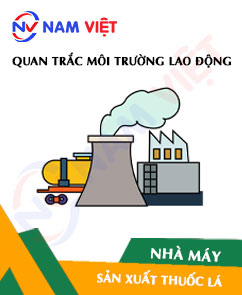
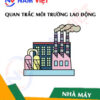
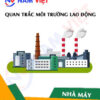
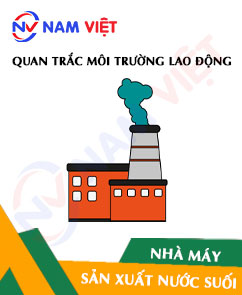


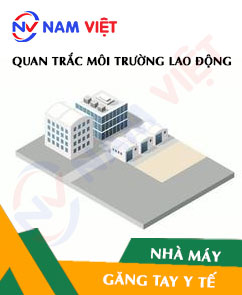




Review Occupational environment monitoring at the factory producing tobacco products
There are no reviews yet.